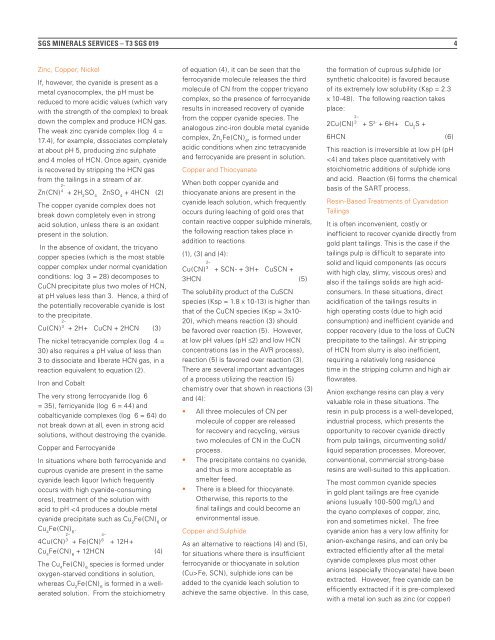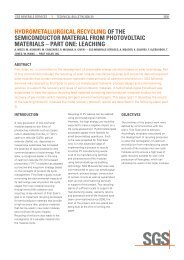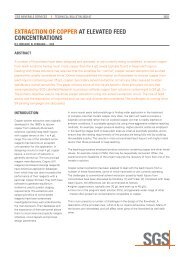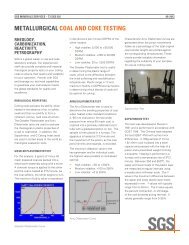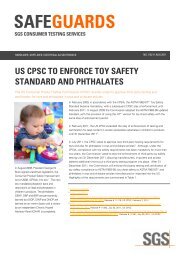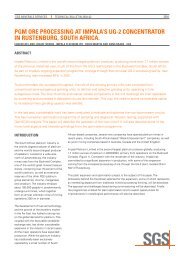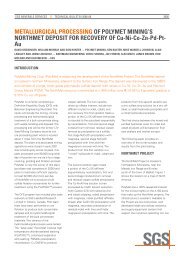You also want an ePaper? Increase the reach of your titles
YUMPU automatically turns print PDFs into web optimized ePapers that Google loves.
<strong>SGS</strong> MINERALS SERVICES – T3 <strong>SGS</strong> 019 4<br />
Zinc, Copper, Nickel<br />
If, however, the cyanide is present as a<br />
metal cyanocomplex, the pH must be<br />
reduced to more acidic values (which vary<br />
with the strength of the complex) to break<br />
down the complex and produce HCN gas.<br />
The weak zinc cyanide complex (log ⇔4 =<br />
17.4), for example, dissociates completely<br />
at about pH 5, producing zinc sulphate<br />
and 4 moles of HCN. Once again, cyanide<br />
is recovered by stripping the HCN gas<br />
from the tailings in a stream of air.<br />
Zn(CN) 4<br />
2–<br />
+ 2H 2 SO 4 ⇔ ZnSO 4 + 4HCN (2)<br />
The copper cyanide complex does not<br />
break down completely even in strong<br />
acid solution, unless there is an oxidant<br />
present in the solution.<br />
In the absence of oxidant, the tricyano<br />
copper species (which is the most stable<br />
copper complex under normal cyanidation<br />
conditions: log ⇔3 = 28) decomposes to<br />
CuCN precipitate plus two moles of HCN,<br />
at pH values less than 3. Hence, a third of<br />
the potentially recoverable cyanide is lost<br />
to the precipitate.<br />
Cu(CN) 3<br />
2–<br />
+ 2H+ ⇔ CuCN + 2HCN (3)<br />
The nickel tetracyanide complex (log ⇔4 =<br />
30) also requires a pH value of less than<br />
3 to dissociate and liberate HCN gas, in a<br />
reaction equivalent to equation (2).<br />
Iron and Cobalt<br />
The very strong ferrocyanide (log ⇔6<br />
= 35), ferricyanide (log ⇔6 = 44) and<br />
cobalticyanide complexes (log ⇔6 = 64) do<br />
not break down at all, even in strong acid<br />
solutions, without destroying the cyanide.<br />
Copper and Ferrocyanide<br />
In situations where both ferrocyanide and<br />
cuprous cyanide are present in the same<br />
cyanide leach liquor (which frequently<br />
occurs with high cyanide-consuming<br />
ores), treatment of the solution with<br />
acid to pH Fe, SCN), sulphide ions can be<br />
added to the cyanide leach solution to<br />
achieve the same objective. In this case,<br />
the formation of cuprous sulphide (or<br />
synthetic chalcocite) is favored because<br />
of its extremely low solubility (Ksp = 2.3<br />
x 10-48). The following reaction takes<br />
place:<br />
2Cu(CN) 3<br />
2–<br />
+ S 2- + 6H+ ⇔ Cu 2 S +<br />
6HCN (6)<br />
This reaction is irreversible at low pH (pH<br />


